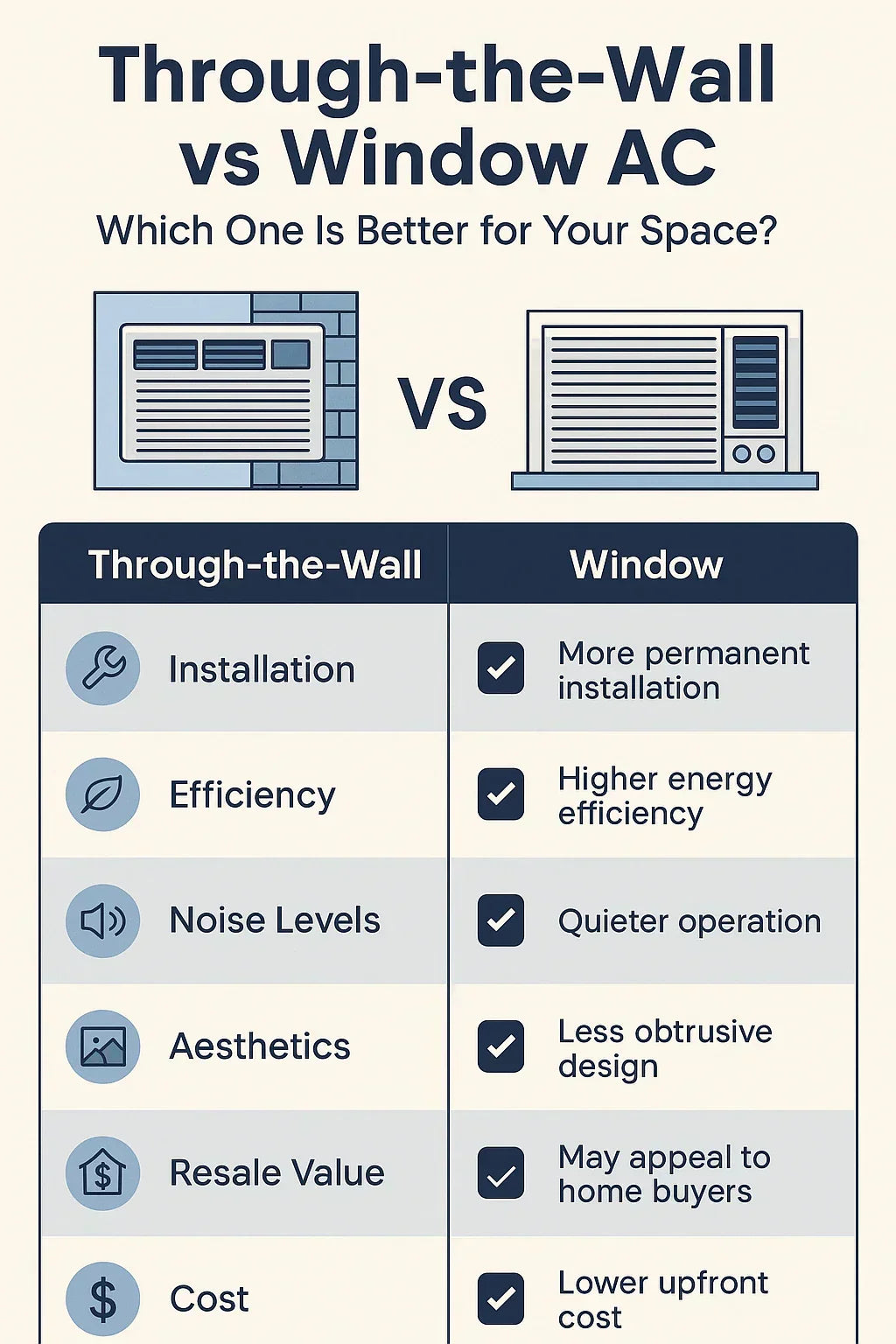🏠 Introduction: Two Popular Cooling Solutions, One Big Decision
When shopping for a new air conditioner, many homeowners find themselves choosing between two common options: through-the-wall (TTW) air conditioners and window air conditioners. Both types serve the same purpose—to keep your home cool and comfortable—but they differ significantly in installation, performance, aesthetics, and long-term value.
In this comprehensive guide, we’ll explore every angle to help you decide whether the Amana 11,600 BTU Through-the-Wall AC or a comparable window unit is the better fit for your space.
🔧 Installation: Fixed vs Portable
Through-the-Wall ACs:
-
Require cutting a hole through an exterior wall.
-
Use a dedicated wall sleeve for stability and proper drainage.
-
Permanent, professional-grade installation.
Window ACs:
-
Slide into an existing window opening.
-
Generally easier to install (DIY-friendly).
-
Semi-permanent and easily removable.
For homeowners seeking long-term solutions, TTW units like the Amana PBC122J00AA offer superior permanence.
📏 Space Impact: Clear Windows or Blocked Views?
Through-the-Wall ACs:
-
Preserve full use of windows and natural light.
-
Ideal for rooms where window space is limited or valued.
Window ACs:
-
Occupy window space, blocking views and light.
-
May violate HOA or landlord guidelines.
According to Consumer Reports, TTW units are often preferred in living rooms, sunrooms, or bedrooms where window light is highly desirable.
🔊 Noise Levels: Which Is Quieter?
Through-the-Wall ACs:
-
Quieter operation due to wall sleeve insulation and sturdier mounting.
-
Lower vibration and noise transmission.
Window ACs:
-
Often noisier due to looser mounting and shared window frames.
-
May rattle during operation.
Many apartment dwellers and homeowners report that units like the Amana 11,600 BTU TTW provide whisper-quiet cooling, ideal for bedrooms and offices (Energy Star Noise Ratings).
💡 Energy Efficiency: Who Saves More?
Through-the-Wall ACs:
-
Typically have higher EER (Energy Efficiency Ratio) ratings.
-
Insulate better against outdoor air infiltration.
Window ACs:
-
More prone to air leaks and energy loss around the frame.
-
Vary widely in efficiency depending on fit and insulation.
The Amana model boasts an EER of 10.6, meeting federal energy efficiency standards (AHRI Certified Ratings).
🏗 Durability and Longevity
Through-the-Wall ACs:
-
Built for longer lifespans (10-15 years typical).
-
Less exposure to outdoor elements.
Window ACs:
-
Shorter lifespan (5-10 years typical).
-
More exposure to rain, snow, and debris.
According to The U.S. Department of Energy, TTW units often pay for themselves in longevity and lower maintenance.
💰 Cost Comparison: Short-Term vs Long-Term Investment
Through-the-Wall ACs:
-
Higher upfront cost due to installation and wall sleeve (~$200-$600 additional).
-
Lower maintenance and better energy savings over time.
Window ACs:
-
Lower initial purchase and install costs.
-
May cost more in long-term energy use and replacement cycles.
Energy Star’s Cost Savings Calculator can help estimate total ownership cost.
🔑 When to Choose Each Type
| Criteria | Through-the-Wall | Window |
|---|---|---|
| Homeownership | ✔ | ✔ |
| Rental Properties | Limited | ✔ |
| Long-Term Use | ✔ | Limited |
| Noise Sensitivity | ✔ | ✘ |
| Energy Efficiency | ✔ | Variable |
| Preserving Window Views | ✔ | ✘ |
| Installation Cost | Higher | Lower |
🎯 Conclusion: Which One Is Right for You?
If you’re looking for a permanent, quiet, efficient, and aesthetically pleasing solution—the Amana 11,600 BTU Through-the-Wall AC is the clear winner for homeowners or long-term renters. However, for temporary living situations, limited budgets, or frequent moves, window units remain a practical option.
Always consider your space, budget, and long-term comfort when making your decision.
In the next topic we will read about: Can You Install a Through-the-Wall AC Yourself? A Step-by-Step Guide







